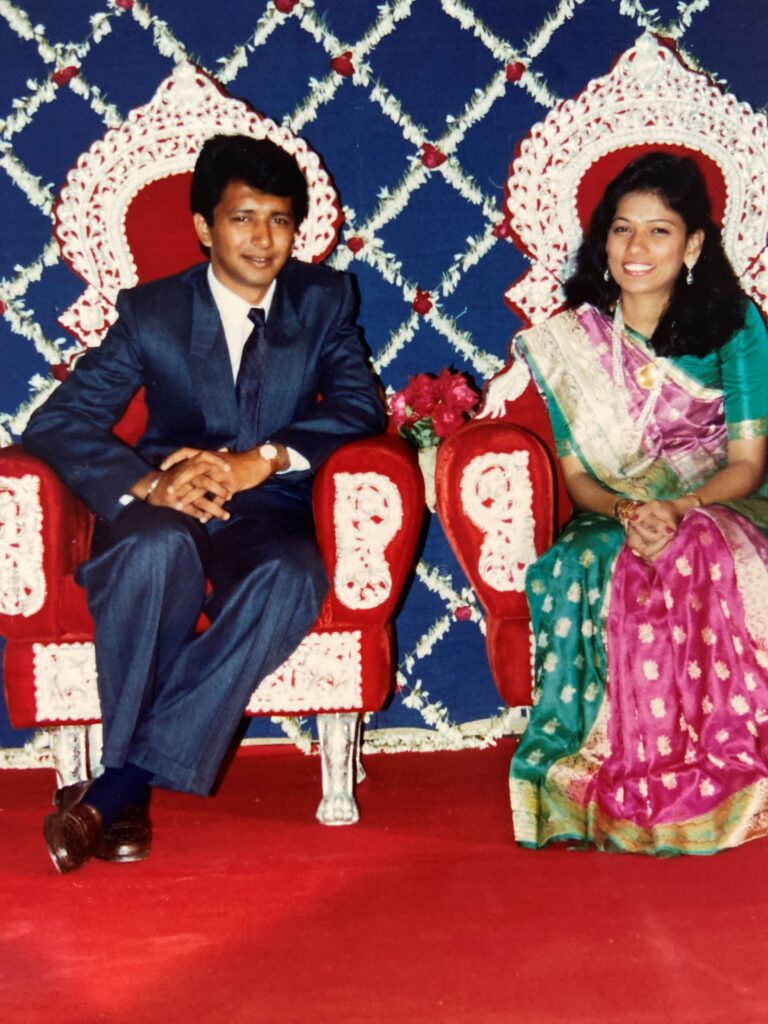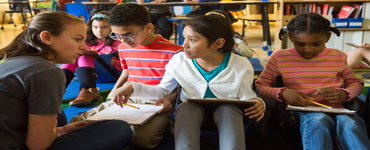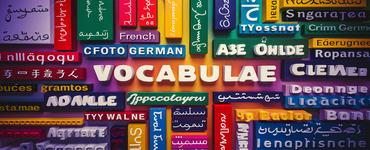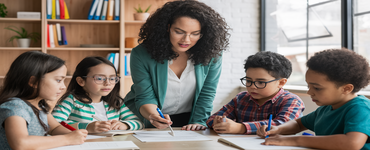Drawing from personal experiences as a multilingual learner and educator, this article advocates for inclusive literacy instruction that values the diverse backgrounds and experiences of students, challenging the predominant ways of teaching reading.
Keywords: reading, reading instruction, literacy, immigrant education, newcomers, language arts
As a professional learning specialist, I’ve had the privilege of presenting workshops on reading for hundreds of educators around the country. I always start by asking everyone to reflect on how they became a reader – not just how you learned to read, but how did you come to take up reading as a part of your identity? Some share about special memories of reading with a family member, some share about a particular book that touched their heart, and some share about how a teacher made them feel confident about reading. These deeply personal and emotional connections to reading are part of what makes literacy teaching such a unique opportunity in the classroom to bring in the rich home and community literacy experiences and background knowledge of our multilingual learners.
Research-informed recommendations can improve outcomes for reading; however, the recent pushes for science-based reading instruction often sideline the experiences and needs of multilingual learners (Aukerman & Schuldt, 2021; Noguerón‐Liu, 2020; Thomas, 2022). In this article, I offer a few ways to expand instruction to be inclusive of multilingual learners through sharing both my own experiences as a multilingual learner who grew up in rural Minnesota and how I’ve reconciled these experiences with current reading research.
Moving towards authentic, culturally sustaining connections to learning
Growing up in a rural part of Minnesota, I was different from my classmates. My culture, my language, and my race were rarely represented in texts and curriculum. Once in elementary school, I had a well-intended teacher try to provide me with some “diverse” texts. She had a small group of us read the book Homeless Bird by Gloria Whelan. The story follows a young Indian girl who has an arranged marriage as a child and subsequently experiences hardship after hardship.The text paints arranged marriage as something heartless parents do to throw their daughters away rather than a valued tradition with deep cultural roots (see Figure 1 for an image of my own parents). After reading this text, I felt so deeply embarrassed that, for about a decade, I avoided reading other books with anyone who looked like me. As a child, I didn’t have enough experience seeing myself positively represented in school to understand that this was just a book written by someone who failed to understand the culture and content that they were writing about and instead perpetuated stereotypes. So, instead of feeling represented, this text did the work of chipping away at my identity and lowering my self-esteem.

While negative representations can have a harmful impact, positive and authentic representations are one powerful way to move toward an equitable and asset-based classroom. Incorporating a diverse range of reading materials that represent various perspectives, cultures, and linguistic practices that resonate with students’ lives can foster a more effective learning environment. In fact, researchers suggest that sometimes challenges in reading comprehension are context dependent, suggesting that students who rarely have the opportunity to read texts that reflect their background knowledge are at a disadvantage compared to students who have the privilege of consistently seeing their background knowledge represented in texts (Duke & Cartwright, 2020). This emphasis on representing diverse experiences in texts not only enhances comprehension for minoritized students but also creates learning opportunities for all students.
Finding authentic resources is key when it comes to representation, and this requires a deep understanding of who our students are coupled with some investigation into the context and content of texts. In 2016, a researcher conducted a study to understand representation in children’s books about Asian-American Pacific Islander (AAPI) characters or culture. Her findings revealed that out of the 237 books that contained content related to AAPI people or culture, only 32% were written by AAPI authors (Yi, 2020). More recent statistics give a glimmer of hope as the number of books written by diverse authors has increased significantly in the last ten years (Dickinsen, 2023). I am hopeful that this trend means that building diverse and authentic classroom libraries will become more and more feasible.
In my story, I know my teacher meant well, but the outcome was still harmful to me. Seeing my cultural identity represented in such a demeaning way might have been easier to overcome if the negative experience had been diluted with other experiences of seeing myself positively and authentically represented. This is one reason why it is vital for students to be consistently represented in both fiction and non-fiction and across content areas.
However, knowing how to select authentic texts is challenging, especially when you are not from the group that is being represented. The Minnesota Humanities Center has created a powerful, easy to use resource assessment tool to support educators in evaluating the quality of instructional materials. They also have a separate tool with specific considerations for evaluating and selecting Native American resources. Resources such as this can make a big positive difference in guiding teachers to select culturally sustaining resources.
Asking the right questions

Every evening growing up, my grandmother (see Figure 2) and mom would sit cross-legged in front of our family altar and sing prayers in Sanskrit. These prayers, committed to the memories of all the members of my family, are a precious part of my home literacy practices. Afterwards, my grandmother would read her prayer book and tell me religious stories and then we would have discussions like what had made me upset at school that day and why it is important to have compassion toward those that hurt you and how to let go of anger.
These daily evening experiences for me are a powerful part of my literacy journey and these experiences were valuable resources for learning that I brought with me to the classroom. Like me, many multilingual learners from diverse backgrounds bring their own life experiences to the classroom and it is critical for educators to take on an asset-based mindset and to expand beyond Eurocentric views of what counts as literacy.
Researchers emphasize that students benefit when these home and community literacy practices are valued and brought into the classroom as academic resources for learning (Souto-Manning, 2016). While this is true, we must think carefully about how we inquire and learn about our students’ home literacy practices. What assumptions are behind our questions? For example, according to many researchers, oral language is the foundation of reading (Burkins & Yates 2021; Seidenberg & Borkenhagan, 2020). Because of this, educators may be interested in learning more about their multilingual learners’ oral language practices in their home language. If a teacher had just asked me questions like ‘What do you talk about with your family at dinner time?’ They may have walked away thinking I did not have opportunities to build oral language or literacy in my home because for me, dinner time was meant to be a quiet time focused on eating my meal. Maybe I would have even been described as having poor vocabulary in any language. In reality, I had a rich experience of oral language in my home, but there was just a cultural difference in the manner in which it happened.
Because it is so important to learn from students and their families, rather than relying on assumptions and simplistic questions, WIDA has designed a literacy mapping tool and an empathy interview tool to support educators to listen outside the box and understand students’ home literacy experiences. The tools can be found toward the end of this WIDA Focus Bulletin, focused on reading instruction. An empathy interview is a one-on-one interview protocol that supports educators by providing a structured opportunity to ask the right questions and then listen carefully. A literacy mapping activity allows students to reflect on and share the different literacies they see around their homes and communities. This activity can be modified to fit different age groups and can accommodate large class sizes. It works best when the teacher can create a model of their own literacy map.
Decoding is important, but it’s not everything

The summer before kindergarten, my mom and I (see Figure 3) had recently moved to the United States, and I spoke no English. To help me get ready for school, my mom took me to the public library and checked out a set of Hooked on Phonics, and we listened to the audio tapes on repeat (and I mean on repeat). Even though there is nothing extremely special or exciting about phonics cassette tapes, just the fact that I was listening together with my mom made this a special time in my memory. After using Hooked on Phonics for several months, I became a fairly proficient decoder. In fact, I distinctly remember knowing how to “read” all the words in one of my books, all the while, having no idea what anything in the book actually meant. Luckily, at school, I had a wealth of opportunities to practice developing my English oral language and so within a few years, my oral language skills caught up to my decoding skills and I became a proficient and avid reader.
There is a strong relationship between listening comprehension and reading comprehension. In fact, researchers describe reading as listening to the words aloud in your brain (Burkins & Yates, 2021). So, students need the language comprehension necessary to know what the words mean as well as the skills for figuring out the print (Burkins & Yates, 2021). As a teacher, I’ve noticed that because monolingual learners typically come to school with English listening comprehension skills, the English oral language needs of multilingual learners are often overlooked. It is a matter of educational equity for multilingual learners to have access to rich oral language instruction alongside foundational literacy skills instruction because both are critical to developing the skills needed to become a proficient reader.
Leveraging student assets for learning
My mom recalled to me that my kindergarten teacher described me as an extremely talkative and engaged student (see Figure 4), and that I’d speak Gujarati to her, and she’d just listen and pretend to understand me. Luckily for me, I had a wonderful kindergarten teacher who recognized my assets (strong and confident oral language skills) and made me feel like a strong and confident reader. I believe that because of this nurturing classroom environment, I barely noticed the shift from not speaking or reading in English to being a reader who could understand English texts.

Just as my kindergarten teacher leveraged the assets I brought to my learning, it is important that we all do this for all of our students. If we do not intentionally make space for diverse narratives and identities, we end up marginalizing learners. Researchers suggest that we must closely question the dynamic of privilege we create in our classrooms; in particular, we must consider whose practices and knowledge are being leveraged and when, and how this leveraging can lead to impactful learning experiences that “sustain the cultural and linguistic practices of children and youth in our schools, particularly students of color historically deemed as inferior,” (Martínez et al., 2017). The goal of this leveraging is much deeper than celebrating student assets; it is about expanding our students’ existing abilities and supporting them to develop skills so they can be successful in any context (Orellana & Reynolds, 2008).
Conclusion
Recognizing the diverse experiences of multilingual learners is crucial in shaping their journey towards becoming readers. The emphasis on authentic representation, tools for selecting relevant instructional materials, and the importance of balancing decoding skills with oral language development underscores the need for an inclusive approach. By intentionally leveraging student assets and creating impactful learning experiences, educators can support the cultural and linguistic practices of all students, fostering success in diverse contexts. I am very thankful that I had teachers who saw my assets and nurtured them, and I hope as educators, we can continue to discover ways to uplift and encourage our multilingual learners as they navigate their own unique literacy journeys.
References
Aukerman, M., & Chambers Schuldt, L. (2021). What matters most? Toward a robust and socially just science of reading. Reading Research Quarterly, 56(S1), S85-S103. https://doi.org/10.1002/rrq.406
Burkins, J., & Yates, K. (2021). Shifting the balance: 6 ways to bring the science of reading into the balanced literacy classroom. Stenhouse Publishers.
Dickinson, K. (2023, June 13). CCBC’s latest diversity statistics show increasing number of diverse books for children and teens. School of Education. https://education.wisc.edu/news/ccbcs-latest-diversity-statistics-show-increasing-number-of-diverse-books-for-children-and-teens
Duke, N. K., & Cartwright, K. B. (2021). The science of reading progresses: Communicating advances beyond the simple view of reading. Reading Research Quarterly, 56(S1), S25-S44. https://doi.org/10.1002/rrq.411
Martínez, D., Morales, P., & Aldana, U. (2017). Leveraging students’ communicative repertoires as a tool for equitable learning. Review of Research in Education, 41(1), 477-499. https://doi.org/10.3102/0091732X17691741
Noguerón‐Liu, S. (2020). Expanding the knowledge base in literacy instruction and assessment: Biliteracy and translanguaging perspectives from families, communities, and classrooms. Reading Research Quarterly, 56(S1), S307-S318. https://doi.org/10.1002/rrq.354
Orellana M. F., & Reynolds J. F. (2008). Cultural modeling: Leveraging bilingual skills for school paraphrasing tasks. Reading Research Quarterly, 43(1), 48-65. https://doi.org/10.1598/RRQ.43.1.4
Seidenberg, M. S., & Borkenhagen, M. C. (2020). Reading science and educational practice: Some tenets for teachers. The Reading League Journal, 1(1), 7-11
Souto-Manning, M. (2016). Honoring and building on the rich literacy practices of young bilingual and multilingual learners. The Reading Teacher, 70(3), 263-271. https://doi.org/10.1002/trtr.1518
Thomas, P. L. (2022). The Science of Reading movement: The never-ending debate and the need for a different approach to reading instruction. National Education Policy Center. http://nepc.colorado.edu/publication/science-of-reading
Yi, J. H. (2020). Representations, racialization, and resistance: Exploring Asian American picturebooks, 1993-2018 [unpublished doctoral dissertation]. Indiana University, Bloomington, IN. Retrievable from https://hdl.handle.net/2022/26034









